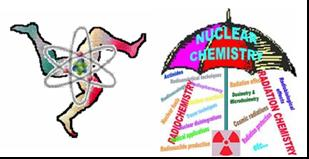Speaker
Mrs
Gülcan Ünak
(Ege University, Faculty of Science, Department of Biochemistry)
Description
2-Fluoro-2-deoxy-D-glucose radiolabeled with Fluorine-18 (18F-FDG) is routinely used in nuclear medicine as a PET imaging radiopharmaceutical and nucleophilicly synthesised, in general, using mannose triflate as a precursor in the presence of Kryptofix 222TM as a catalyst in acetonitrile as a polar aprotic solvent, which involves the SN2 nucleophilic substitution reaction of 18F to 2-position of mannose triflate. The excess of 18F in the reaction medium has been removed by the use of a quaternary ammonium anion exchange Sep-Pak column, known QMA (QMA Sep-PakTM). This reaction process has been applied in routine 18F-FDG synthesis, using fully automatic commercial synthesizing modules. The total synthesizing time of 18F-FDG, using this procedure, requires about 30 - 45 min, which means that an important 18F activity, produced by cyclotron, is lost at the end of this synthesizing procedure. Of course, this raises the cost of 18F-FDG used for PET imaging. In this study, we have tried to develop two different easier and quicker ways for 18F-FDG synthesis, which will be able to be used in routine applications. The first is the isotopic exchange reaction between 18F ion and 19F of 2-fluoro-2-deoxy-D-glucose molecule was realised in water, at 95 ºC, for about 10 min. The second is Selectfluor TM, first tried to be labeled with 18F, then it was used to label 2-deoxy-D-glucose. In both cases, high radiolabeling yields were obtained.
Primary author
Mrs
Gülcan Ünak
(Ege University, Faculty of Science, Department of Biochemistry)
Co-authors
Mrs
Cigdem Cetin
(Ege University, Faculty of Science, Department of Chemistry, Division of Nuclear Chemistry)
Mrs
Gozde Sarican
(Ege University, Faculty of Science, Department of Chemistry, Division of Nuclear Chemistry)
Mrs
Selen Ekim
(Ege University, Faculty of Science, Department of Chemistry, Division of Nuclear Chemistry)
Prof.
Turan Ünak
(Ege University, Faculty of Science, Department of Chemistry, Division of Nuclear Chemistry)




